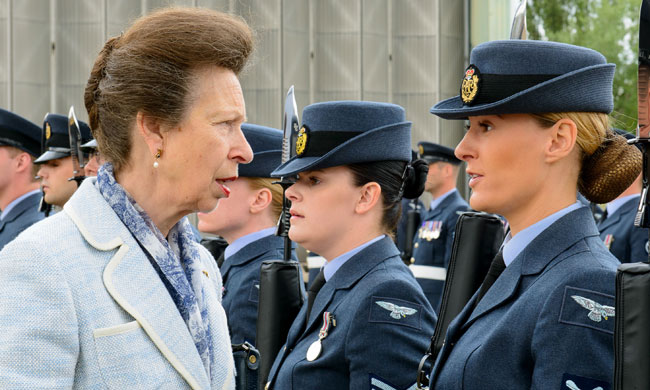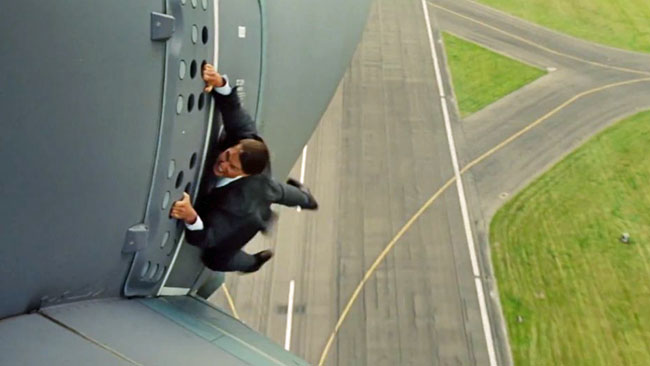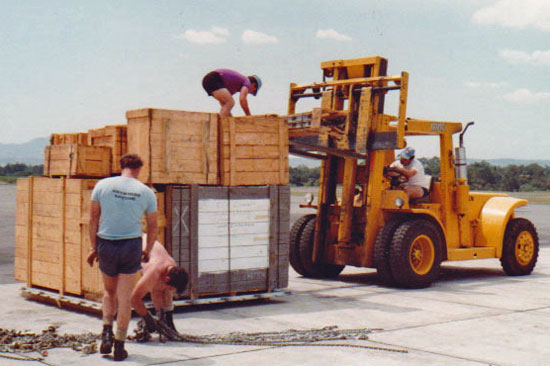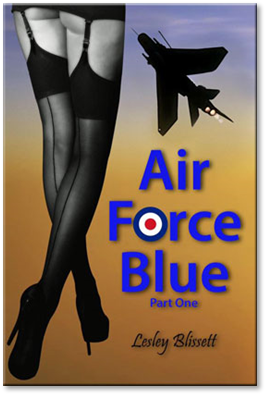
70 Squadron Stood Up by Princess Anne.
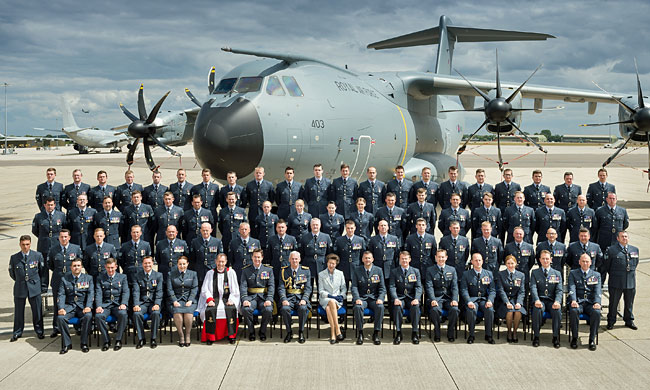
A squadron operating a new fleet of aircraft at RAF Brize Norton was praised and celebrated by HRH Princess Royal on Thursday 23rd July. Princess Anne stopped by the base at around 11am to mark the official re-formation of the Number LXX (70) Squadron after it stood down in 2010.
The squadron, which was previously based at RAF Lyneham for 30 years, is marking a new beginning by becoming the RAF’s first ever frontline unit to operate Airbus A400M Atlas.
No. LXX Squadron was also presented with a new standard - a special military flag which marks the trust bestowed on the squadron by the monarch. It bears the squadron insignia and battle honours.
The squadron, which was previously based at RAF Lyneham for 30 years, is marking a new beginning by becoming the RAF’s first ever frontline unit to operate Airbus A400M Atlas.
No. LXX Squadron was also presented with a new standard - a special military flag which marks the trust bestowed on the squadron by the monarch. It bears the squadron insignia and battle honours.
The Princess Royal, who is honorary air commodore at RAF Brize Norton, said it was a “relief” and a “pleasure” to be able to present No. LXX with their third standard. She said: “This is a significant milestone as the unit re-forms as the first dedicated front line squadron to operate Atlas A400M. It is always encouraging to see many elements of the process turning out to support the squadron. Whether you are serving in the RAF, the civil service or the industry, you should be very proud."
Oxford Mail
Oxford Mail
From: Bill Girdwood, London W5
Sent: Tuesday, June 30, 2015 2:57 AM
Subject: Re: UKMAMS OBA OBB #063015
Hi Tony,
Many thanks for latest Newsletter; splendid as always and much anticipated each month! The late extra note on the C17 trip to Tunis was excellently informative. Well done MOD PR!
What it suggested to me was that I am entirely ignorant of the different roles all movers must now be 'au fait' with on many different types of aircraft, including helicopters. Perhaps over the months we might have a series of factual aircraft details with accompanying photographic illustrations of the floor plans/tie down gear etc. Also, perhaps the Movs School could walk us over the way they now teach young movers their trade. I bet it is a little different to that which we experienced!
Very best wishes
Bill
Sent: Tuesday, June 30, 2015 2:57 AM
Subject: Re: UKMAMS OBA OBB #063015
Hi Tony,
Many thanks for latest Newsletter; splendid as always and much anticipated each month! The late extra note on the C17 trip to Tunis was excellently informative. Well done MOD PR!
What it suggested to me was that I am entirely ignorant of the different roles all movers must now be 'au fait' with on many different types of aircraft, including helicopters. Perhaps over the months we might have a series of factual aircraft details with accompanying photographic illustrations of the floor plans/tie down gear etc. Also, perhaps the Movs School could walk us over the way they now teach young movers their trade. I bet it is a little different to that which we experienced!
Very best wishes
Bill
From: Ian Berry, West Swindon
Sent: Friday, July 03, 2015 7:30 AM
Subject: Wagon Wheel Origins
Hi Tony,
Mick Hughes from Oz enquired about the origins of the wagon wheel as a Movements emblem. I cannot be specific but it did appear as an armband/brassard in the early 1970s. The symbol is the NATO tactical symbol used on orbats/battle plans for a transportation/movements unit.
Although many RAF movers, including UKMAMS personnel, were issued with the armband we quickly stopped using it after the Norwegians complained that it closely resembled the quisling symbol (Norwegian traitor) used in WW2 and to save offence we introduced an RAF Movs armband in red and gold. The then RCT (Royal Corps of Transport) and now RLC (Royal Logistics Corps) Movers did not take the hint and continue to wear it as it is still recognised within NATO.
Cheers for now,
Ian
Sent: Friday, July 03, 2015 7:30 AM
Subject: Wagon Wheel Origins
Hi Tony,
Mick Hughes from Oz enquired about the origins of the wagon wheel as a Movements emblem. I cannot be specific but it did appear as an armband/brassard in the early 1970s. The symbol is the NATO tactical symbol used on orbats/battle plans for a transportation/movements unit.
Although many RAF movers, including UKMAMS personnel, were issued with the armband we quickly stopped using it after the Norwegians complained that it closely resembled the quisling symbol (Norwegian traitor) used in WW2 and to save offence we introduced an RAF Movs armband in red and gold. The then RCT (Royal Corps of Transport) and now RLC (Royal Logistics Corps) Movers did not take the hint and continue to wear it as it is still recognised within NATO.
Cheers for now,
Ian
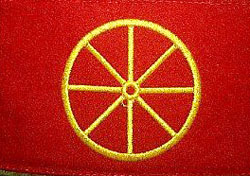

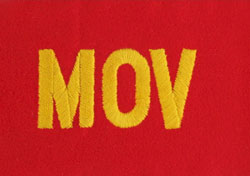
From: Victor Smith, Brassall, QLD
Sent: Saturday, July 04, 2015 8:05 PM
Subject: Mover Brassard
Tony,
In your latest newsletter, Mick Hughes asked the question "I am curious to know how the "wagon wheel" emblem became associated with Movers. Does anyone know?".
One story passed to me was that it goes back in history to the King’s Army. A battle is lost because the supply wagons cannot be found. Hence the King decrees that thereafter the people running his supply wagons will be easily identifiable by wearing a Brassard. The Brassard was to consist of a wagon wheel design on a red background; the wagon wheel being symbolic of the means of transporting the supplies.
Cheers
Vic
Sent: Saturday, July 04, 2015 8:05 PM
Subject: Mover Brassard
Tony,
In your latest newsletter, Mick Hughes asked the question "I am curious to know how the "wagon wheel" emblem became associated with Movers. Does anyone know?".
One story passed to me was that it goes back in history to the King’s Army. A battle is lost because the supply wagons cannot be found. Hence the King decrees that thereafter the people running his supply wagons will be easily identifiable by wearing a Brassard. The Brassard was to consist of a wagon wheel design on a red background; the wagon wheel being symbolic of the means of transporting the supplies.
Cheers
Vic
From: Len Bowen, Chisholm, ACT
Sent: Tuesday, June 30, 2015 6:12 AM
Subject: Movements Wagon Wheel Origin
G’day Tony,
Many thanks for the latest newsletter; excellent as usual. No doubt you will already have been flooded with replies ref the Origin of the Movements Wheel, but just in case:…..
The Royal Waggon* Train, later the Royal Corps of Waggoners was the first formally formed and recognised support (logistics) element of the British Army.
In 1793, when Revolutionary French forces invaded the ‘Low Countries’, now the Netherlands, and declared war on Britain, the old concept of armed forces ‘living off the land’ and foraging for themselves as they advanced or retreated, assisted where possible by local agents, proved totally inadequate. As a result the first uniformed transport corps, named the Royal Waggoners, was created in March 1794 to bring up rations, animal fodder and munitions to the advancing English troops.
The rest, as they say, is history, and can be traced through the Royal Wagon Train (1802 - 1832), the Royal Army Service Corps, the Royal Corps of Transport and the Royal Logistics Corps. Add ‘Australian’ as a prefix up to, but not including, the Really Large Corps (sorry, UK Green machine!) for the Oz equivalent.
Wikipedia and many other such search engines will give more detailed histories. Suffice it to say that, after the Peninsular War and Waterloo, Field Marshal Arthur Wellesley, 1st Duke of Wellington said, “No person can be more impressed than I am of the absolute necessity of a corps of the description of the Royal Waggon Train.” As a result the wagon [sic] wheel was later adopted as a Movements insignia throughout Commonwealth military logistic transport services.
Sent: Tuesday, June 30, 2015 6:12 AM
Subject: Movements Wagon Wheel Origin
G’day Tony,
Many thanks for the latest newsletter; excellent as usual. No doubt you will already have been flooded with replies ref the Origin of the Movements Wheel, but just in case:…..
The Royal Waggon* Train, later the Royal Corps of Waggoners was the first formally formed and recognised support (logistics) element of the British Army.
In 1793, when Revolutionary French forces invaded the ‘Low Countries’, now the Netherlands, and declared war on Britain, the old concept of armed forces ‘living off the land’ and foraging for themselves as they advanced or retreated, assisted where possible by local agents, proved totally inadequate. As a result the first uniformed transport corps, named the Royal Waggoners, was created in March 1794 to bring up rations, animal fodder and munitions to the advancing English troops.
The rest, as they say, is history, and can be traced through the Royal Wagon Train (1802 - 1832), the Royal Army Service Corps, the Royal Corps of Transport and the Royal Logistics Corps. Add ‘Australian’ as a prefix up to, but not including, the Really Large Corps (sorry, UK Green machine!) for the Oz equivalent.
Wikipedia and many other such search engines will give more detailed histories. Suffice it to say that, after the Peninsular War and Waterloo, Field Marshal Arthur Wellesley, 1st Duke of Wellington said, “No person can be more impressed than I am of the absolute necessity of a corps of the description of the Royal Waggon Train.” As a result the wagon [sic] wheel was later adopted as a Movements insignia throughout Commonwealth military logistic transport services.
The iconic red Movements arm band, with or without the Wheel, really came into its own in Britain during WWI and later in WWII, when a vast number of personnel traveled throughout UK by rail, either as formed units or individuals. There was a Rail Transport Office (RTO) at almost every railway station throughout the land, and the offices and their staffs were on site to provide a focus for arrivals and departures seeking advice and information for their onwards movements - or just somewhere for a hot meal and a place to kip for the night before their train departed. A sailor, soldier or airman passing through one of the rail transport hubs only had to locate a uniformed member wearing a red arm band to find a (usually**) friendly face and a guiding hand.
The history of the red arm band continued/continues to the present day, though again not always with the wheel. I have in my personal collection a red Movements arm band carrying a brass Australian wedgetail eagle and a king’s crown insignia, but without a wheel, placing this as RAAF Air Movements pre-1952/53, as when on Her Majesty’s ascended to the throne the Queen’s Crown was adopted on all military insignia.
Hope this is of interest.
Ref ‘turbulence’; too late on parade as usual, but I do remember being down the back in 34 Squadron Beverley XH116 with Flt Lt Dave Maslin as skipper en-route from Calcutta to RAF Seletar, Singapore, on 1st April 1967. Returning from a recce for a forthcoming India Aid Mission task to Nepal, we hit the edge of a cyclone over the Bay of Bengal and at one point were as near as a Bev ever would be inverted and survive the experience.
What happened with the two ‘Elsan’ chemical toilets in the far end of the boom does not bare repeating here. Whoever decided to return direct to Seletar instead of the usual night stop at RAAF Butterworth along the route obviously decided on an April First (sick) joke, as my log book records 11 hours and 10 minutes for the flight, the longest Bev run by far in my time on FEAF MAMS. With or without a cyclone, that was a hell of a run in a Bev, even with no load and a serious tail wind.
Yrs Aye,
Len Bowen
*Correct period spelling.
** Well even Movers have their off days!
The history of the red arm band continued/continues to the present day, though again not always with the wheel. I have in my personal collection a red Movements arm band carrying a brass Australian wedgetail eagle and a king’s crown insignia, but without a wheel, placing this as RAAF Air Movements pre-1952/53, as when on Her Majesty’s ascended to the throne the Queen’s Crown was adopted on all military insignia.
Hope this is of interest.
Ref ‘turbulence’; too late on parade as usual, but I do remember being down the back in 34 Squadron Beverley XH116 with Flt Lt Dave Maslin as skipper en-route from Calcutta to RAF Seletar, Singapore, on 1st April 1967. Returning from a recce for a forthcoming India Aid Mission task to Nepal, we hit the edge of a cyclone over the Bay of Bengal and at one point were as near as a Bev ever would be inverted and survive the experience.
What happened with the two ‘Elsan’ chemical toilets in the far end of the boom does not bare repeating here. Whoever decided to return direct to Seletar instead of the usual night stop at RAAF Butterworth along the route obviously decided on an April First (sick) joke, as my log book records 11 hours and 10 minutes for the flight, the longest Bev run by far in my time on FEAF MAMS. With or without a cyclone, that was a hell of a run in a Bev, even with no load and a serious tail wind.
Yrs Aye,
Len Bowen
*Correct period spelling.
** Well even Movers have their off days!
Six decades of RAF history ends as new rescue base opens
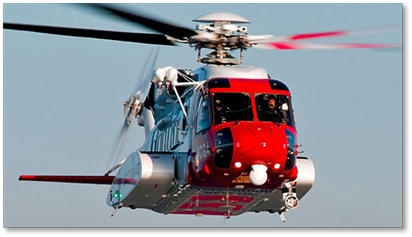
Sixty years of RAF service officially comes to an end today with a private operator taking over search and rescue in North Wales. Bristow Helicopters have a contract to run the service for a decade with new Sikorsky S-92 aircraft, in a deal that was agreed in 2013.
The search and rescue operations base has moved from Valley on Anglesey to a new base at Caernarfon, with further services launching from St Athan in the Vale of Glamorgan from October.
The phasing out of the distinctive yellow helicopters of C Flight, 22 Search and Rescue Squadron of the Royal Air Force on Anglesey began in April. Until this year the RAF Valley base has been responsible for deploying rescue teams, carrying out well over 9,000 rescue operations.
The search and rescue operations base has moved from Valley on Anglesey to a new base at Caernarfon, with further services launching from St Athan in the Vale of Glamorgan from October.
The phasing out of the distinctive yellow helicopters of C Flight, 22 Search and Rescue Squadron of the Royal Air Force on Anglesey began in April. Until this year the RAF Valley base has been responsible for deploying rescue teams, carrying out well over 9,000 rescue operations.
In lieu of the distinctive yellow Sea Kings, the two Sikorsky helicopters based at Caernarfon will cover an area of 250 nautical miles around the base and each carry three stretchers and up to 10 seated casualties.
Both helicopters will have a crew of four and be capable of flying at 145 nautical miles an hour. Bristow say two thirds of staff at the new Caernarfon base comprise of current serving military personnel that have already secured employment with Bristow Helicopters.
ITV Wales
Both helicopters will have a crew of four and be capable of flying at 145 nautical miles an hour. Bristow say two thirds of staff at the new Caernarfon base comprise of current serving military personnel that have already secured employment with Bristow Helicopters.
ITV Wales
From: Syd Avery, Guardamar del Segura
Sent: Wednesday, July 08, 2015 3:16 AM
Subject: A day in retirement
We have a cockpit mock-up in a walk-in closet in our house.
When I mention to my wife that I miss flying, she puts me in the mock-up around bed time for 8 hours.
She has a chair in the closet, puts on the vacuum cleaner on the chair to simulate cockpit air noise, has a dim nite-lite to simulate cockpit lighting, serves luke-warm chicken with cold vegetables on a tray.
When I get sleepy and attempt to doze off, she knocks twice loudly on the door to simulate the Flight Attendant entering the cockpit.
Then after 6 hours she turns on a flood light directly in front of me to simulate the sun coming up when heading Westbound at 5:00 am.
I then get a cup of coffee that has been in the coffee maker all night.
Finally she lets me out and I have to get in the back seat of her car while she runs morning errands to simulate the bus ride to the hotel.
When we get home I tell her I am ready for bed, the bedroom door is locked for an hour to simulate the hotel rooms not being ready.
When I promise to never "complain" again about being retired, I am allowed to enjoy my "layover" and go to bed.
Oh... and one more thing, she talks to her friends loudly outside the bedroom door on the phone to simulate the hotel maids chattering in the hall in some foreign language.
After two hours of sleep she calls the phone next to the bed from her cell and says "This is crew scheduling and we have a reroute for you. Do you have something to write with?"
No, I guess I really don't miss it after all .
Regards
Syd
Sent: Wednesday, July 08, 2015 3:16 AM
Subject: A day in retirement
We have a cockpit mock-up in a walk-in closet in our house.
When I mention to my wife that I miss flying, she puts me in the mock-up around bed time for 8 hours.
She has a chair in the closet, puts on the vacuum cleaner on the chair to simulate cockpit air noise, has a dim nite-lite to simulate cockpit lighting, serves luke-warm chicken with cold vegetables on a tray.
When I get sleepy and attempt to doze off, she knocks twice loudly on the door to simulate the Flight Attendant entering the cockpit.
Then after 6 hours she turns on a flood light directly in front of me to simulate the sun coming up when heading Westbound at 5:00 am.
I then get a cup of coffee that has been in the coffee maker all night.
Finally she lets me out and I have to get in the back seat of her car while she runs morning errands to simulate the bus ride to the hotel.
When we get home I tell her I am ready for bed, the bedroom door is locked for an hour to simulate the hotel rooms not being ready.
When I promise to never "complain" again about being retired, I am allowed to enjoy my "layover" and go to bed.
Oh... and one more thing, she talks to her friends loudly outside the bedroom door on the phone to simulate the hotel maids chattering in the hall in some foreign language.
After two hours of sleep she calls the phone next to the bed from her cell and says "This is crew scheduling and we have a reroute for you. Do you have something to write with?"
No, I guess I really don't miss it after all .
Regards
Syd
RNZAF brings Anjalee home
On June 21, the RNZAF brought an eight-year-old Asian elephant home to her new enclosure at Auckland Zoo in a C-130 Hercules - earning high praise from the Director of Auckland Zoo, Jonathan Wilcken.
He says working with Air Force personnel to relocate the Sri Lankan elephant was an extremely positive experience for zoo staff. In a letter to WGCDR Richard Beaton, he says: “It has been a huge privilege for our zoo staff to work with the flight and ground crew of the squadron in the planning and execution of this challenging and unusual initiative.
“I would like to make particular mention of SGT David Cresswell, FLTLT Nicola Durie and F/S Chris McMahon. From our initial planning meetings with Chris through to the successful culmination of the project yesterday, they have provided an incredible level of enthusiasm, professionalism and commitment to ensure the safe and comfortable delivery of Anjalee to Niue and then to Auckland.
“I am sure that New Zealanders now better appreciate that in a complex and time critical task like this they are well served by dedicated service personnel.”
Anjalee touched down at Whenuapai after three months in quarantine in Nuie before heading to her new home at Auckland Zoo. Anjalee is now settling into her new home with Burma and was visited by RNZAF personnel on 29 June.
He says working with Air Force personnel to relocate the Sri Lankan elephant was an extremely positive experience for zoo staff. In a letter to WGCDR Richard Beaton, he says: “It has been a huge privilege for our zoo staff to work with the flight and ground crew of the squadron in the planning and execution of this challenging and unusual initiative.
“I would like to make particular mention of SGT David Cresswell, FLTLT Nicola Durie and F/S Chris McMahon. From our initial planning meetings with Chris through to the successful culmination of the project yesterday, they have provided an incredible level of enthusiasm, professionalism and commitment to ensure the safe and comfortable delivery of Anjalee to Niue and then to Auckland.
“I am sure that New Zealanders now better appreciate that in a complex and time critical task like this they are well served by dedicated service personnel.”
Anjalee touched down at Whenuapai after three months in quarantine in Nuie before heading to her new home at Auckland Zoo. Anjalee is now settling into her new home with Burma and was visited by RNZAF personnel on 29 June.
Cpl Vanisha Patel, Communications Technician & Auckland Zoo Volunteer: As a communications technician, my day-to-day job is usually really interesting and has shown me I really like helping - people and animals alike. That’s what led me to volunteering at Auckland Zoo. I’ve been volunteering for close to two years now and there have been many highlights. One of my favourite animals is Burma, Auckland Zoo’s female Asian elephant. Burma had been living on her own at Auckland Zoo since her companion Kashin passed away in 2009, but now she’s got a new friend in eight-year-old female Asian elephant Anjalee.
Following Anjalee’s required 90-day quarantine period on Niue Island, the RNZAF got to play a major role in safely transporting Anjalee to Auckland Zoo - the final leg of her very long journey from Sri Lanka’s Pinnawala Elephant Orphanage. 40 SQN were tasked with packaging, loading and flying Anjalee on a C-130 Hercules and, as luck would have it, I was able to be part of the team on this memorable trip.
Anjalee was led into her crate at around 0630hrs, and then hoisted onto a truck and driven to the airport where the C-130 was waiting. It was a quick and smooth process as we carefully slid the pallet she was on into the Hercules. Her crate was secured down, last passengers loaded and then we took off. Anjalee was a very well behaved passenger, with her inflight rations consisting of sugar cane, bananas and some tasty pellets. I found myself a little bewildered every time I’d turn around and there was an elephant on board! .
Towards our landing she vocalised with a few trumpeting sounds that she was keen to be on the ground. An odd sound to hear on a plane! Our landing was nice and smooth. Anjalee was unloaded on to a truck and whisked away to her new home at Auckland Zoo.
It’s been an awe inspiring experience to be part of this task. Auckland Zoo has been waiting a long time for their new family member to join Burma. I feel very privileged to have been part of the journey in bringing Anjalee home.
Following Anjalee’s required 90-day quarantine period on Niue Island, the RNZAF got to play a major role in safely transporting Anjalee to Auckland Zoo - the final leg of her very long journey from Sri Lanka’s Pinnawala Elephant Orphanage. 40 SQN were tasked with packaging, loading and flying Anjalee on a C-130 Hercules and, as luck would have it, I was able to be part of the team on this memorable trip.
Anjalee was led into her crate at around 0630hrs, and then hoisted onto a truck and driven to the airport where the C-130 was waiting. It was a quick and smooth process as we carefully slid the pallet she was on into the Hercules. Her crate was secured down, last passengers loaded and then we took off. Anjalee was a very well behaved passenger, with her inflight rations consisting of sugar cane, bananas and some tasty pellets. I found myself a little bewildered every time I’d turn around and there was an elephant on board! .
Towards our landing she vocalised with a few trumpeting sounds that she was keen to be on the ground. An odd sound to hear on a plane! Our landing was nice and smooth. Anjalee was unloaded on to a truck and whisked away to her new home at Auckland Zoo.
It’s been an awe inspiring experience to be part of this task. Auckland Zoo has been waiting a long time for their new family member to join Burma. I feel very privileged to have been part of the journey in bringing Anjalee home.
RNZAF News / Auckland Zoo
From: Tony Freeman, Thornhill, Dumfries
Sent: Saturday, July 18, 2015 9:25 AM
Subject: The best trip ever!
Thank you Tony. The best trip I went on was as leader of a UKMAMS team during the First Gulf War when, after hostilities had ceased, we flew from Cyprus to Dhahran to return the Rumanian Field Hospital from Saudi to Bucharest. The exercise involved several round trips by VC10 so we had to stay in Bucharest to supervise each offload. Before departure, I sent a signal to the Defence Attaché in Bucharest requesting a hotel booking. When we arrived, I spotted what looked like him on the pan and asked where we were to stay and did he receive my signal?
Needless to say, he hadn't so he allowed us to stay at his residence where we enjoyed good food, his whisky and accommodation. When we were about to return to Cyprus I asked him what we owed for his hospitality and paid him out of the imprest. On returning to the UK, I discovered that he may have received an allowance for that kind of thing! Might be a wind up, I will never know. That said, he entertained us royally and showed us the 'sights' of Bucharest which was still heavily damaged after the recent revolution. The President's Palace was awesome and there was a very long queue outside one shop which, I discovered was for a recent delivery of soap powder! What a contrast!
As a postscript, when we first arrived in Saudi, a squadron leader appeared in desert combats, covered in sand, reminiscent of a scene from Lawrence of Arabia and tagged along with us (and my imprest) as he was the liaison officer for the field hospital. He had to stay behind in Bucharest to attend the funerals of two nurses who had died through drinking anti-freeze booze! I didn't think I would ever see him again; just two short weeks later when we were in Tesco's in Abingdon, who should walk around the end of an aisle. ... ?
You couldn't make it up and I have dined out on this story ever since!
Best wishes
Tony
Sent: Saturday, July 18, 2015 9:25 AM
Subject: The best trip ever!
Thank you Tony. The best trip I went on was as leader of a UKMAMS team during the First Gulf War when, after hostilities had ceased, we flew from Cyprus to Dhahran to return the Rumanian Field Hospital from Saudi to Bucharest. The exercise involved several round trips by VC10 so we had to stay in Bucharest to supervise each offload. Before departure, I sent a signal to the Defence Attaché in Bucharest requesting a hotel booking. When we arrived, I spotted what looked like him on the pan and asked where we were to stay and did he receive my signal?
Needless to say, he hadn't so he allowed us to stay at his residence where we enjoyed good food, his whisky and accommodation. When we were about to return to Cyprus I asked him what we owed for his hospitality and paid him out of the imprest. On returning to the UK, I discovered that he may have received an allowance for that kind of thing! Might be a wind up, I will never know. That said, he entertained us royally and showed us the 'sights' of Bucharest which was still heavily damaged after the recent revolution. The President's Palace was awesome and there was a very long queue outside one shop which, I discovered was for a recent delivery of soap powder! What a contrast!
As a postscript, when we first arrived in Saudi, a squadron leader appeared in desert combats, covered in sand, reminiscent of a scene from Lawrence of Arabia and tagged along with us (and my imprest) as he was the liaison officer for the field hospital. He had to stay behind in Bucharest to attend the funerals of two nurses who had died through drinking anti-freeze booze! I didn't think I would ever see him again; just two short weeks later when we were in Tesco's in Abingdon, who should walk around the end of an aisle. ... ?
You couldn't make it up and I have dined out on this story ever since!
Best wishes
Tony
From: Rob Davies, Woodchurch, Kent
Sent: Friday, July 17, 2015 8:58 AM
Subject: Steam Rally and Air Show
We have the Steam Rally and Air Show at the farm on 1st and 2nd August.
Rob
Sent: Friday, July 17, 2015 8:58 AM
Subject: Steam Rally and Air Show
We have the Steam Rally and Air Show at the farm on 1st and 2nd August.
Rob
Visit the website
Largest line up of Steam in Kent - Weald of Kent Steam Rally, Little Engeham Farm, Woodchurch, Kent. TN26 3QY
With over 40 full size steam engines taking part in arena events, steam ‘working area’ with threshing machines and saw benches, a Victorian Fair complete with Carousel and traditional side shows, Scale steam engines and ride on railways, classic cars, stationary engines, commercial, farming, military vehicles and stalls, there really is something for everyone.
Throughout the weekend there will be steam games to watch and participate in, a restoration marquee giving you access to what goes into bringing these beautiful machines back to life with live demonstrations and why not take a helicopter flight which will allow you to get a bird’s eye view of the beautiful Kent countryside.
Relax and enjoy the stunning surroundings with something from food stalls and the fully licenced bar which will be offering locally brewed beers, ciders and more.
The Weald of Kent Steam Rally is the largest event of its kind in Kent and is a great educational day out for all the family.
To see a YouTube presentation of last year's event click here
With over 40 full size steam engines taking part in arena events, steam ‘working area’ with threshing machines and saw benches, a Victorian Fair complete with Carousel and traditional side shows, Scale steam engines and ride on railways, classic cars, stationary engines, commercial, farming, military vehicles and stalls, there really is something for everyone.
Throughout the weekend there will be steam games to watch and participate in, a restoration marquee giving you access to what goes into bringing these beautiful machines back to life with live demonstrations and why not take a helicopter flight which will allow you to get a bird’s eye view of the beautiful Kent countryside.
Relax and enjoy the stunning surroundings with something from food stalls and the fully licenced bar which will be offering locally brewed beers, ciders and more.
The Weald of Kent Steam Rally is the largest event of its kind in Kent and is a great educational day out for all the family.
To see a YouTube presentation of last year's event click here
Tom Cruise does his most death-defying stunt yet, dangling from an Atlas A400M, in 'Mission Impossible - Rogue Nation'
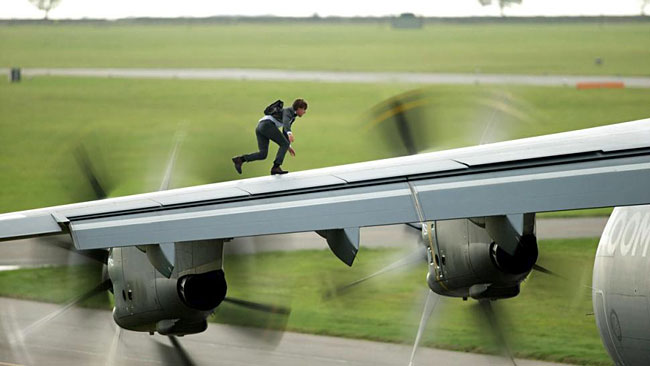
Tom Cruise’s mission for his latest movie was to dangle from the side of a plane for a mid-air stunt that might go down as the most dangerous of his career.
And the 53-year-old adrenaline junkie chose to accept it. It all happens in the opening action sequence of “Mission: Impossible - Rogue Nation,” hitting theaters Friday.
The scene calls for Cruise’s superspy Ethan Hunt to run along the wing of an Airbus A400M, a military transport aircraft, then leap to a side door on the fuselage and hang on for dear life as it took off with a deadly payload inside.
And the 53-year-old adrenaline junkie chose to accept it. It all happens in the opening action sequence of “Mission: Impossible - Rogue Nation,” hitting theaters Friday.
The scene calls for Cruise’s superspy Ethan Hunt to run along the wing of an Airbus A400M, a military transport aircraft, then leap to a side door on the fuselage and hang on for dear life as it took off with a deadly payload inside.
Director Christopher McQuarrie, though, insists Pegg had no reason to fear that his friend would plummet to his doom. His safety lines and harness were rigorously tested. But Cruise - who wore special contact lenses to keep the wind shear from blasting out his eyeballs - was much more likely to die in a number of other ways. “We were never thinking about, ‘Oh my God, he’s going to fall,’” says McQuarrie, who would have no one to blame but himself since he also wrote the screenplay. “We were thinking about the rock that was going to kill him on takeoff or the bird strike that was going to kill him or the unexpected acceleration that was going to kill him. “Even the tiniest grain is going to get sucked through the propellers and fired back right at Tom,” McQuarrie adds. “And in one case a piece of debris hit him in the chest and the only thing that was there to absorb it was the safety harness. It was so tiny, it was like a grain of salt, but he said it felt like a bullet was hitting him in the chest. “Now if a larger rock hit him in the chest or smaller debris hit him in the face, then the show’s over.”
In order to have a wing-mounted camera get both Cruise and the runway in the frame to make the shot more exciting, Airbus test pilot Ed Strongman had to maneuver a faster, vertical takeoff usually reserved for air show tricks. A few pounds of extra pressure from his hand on the throttle could have resulted in Cruise being shorn off the side of the plane and into the next day's headlines. “We could have put Tom on the plane and taken off slower and much more gently,” says stunt coordinator Wade Eastwood, who watched Cruise perform the feat eight times over two days from monitors inside the plane. “It would have still been a dangerous stunt, but we wanted that shot and Tom wanted to have the audience see his feet slipping off the plane and the hands grabbing on for his life to look real. So that’s what we did.” Adds Pegg, “All Tom had to do was have the balls to do it, which is considerable, and survive. That was his only job.”
McQuarrie remembers walking around the entire length of the plane to give Cruise, already tied into place, notes via hand signals over the noise of the engines before the first takeoff. Tom Cruise’s stunts in his latest film are just plane dangerous. “He knew I could hear him and he turned to me and screamed at the top of his lungs, ‘Just remember, if I look like I’m panicking, it’s because I’m acting. Don’t cut.’”
In this age of CGI technology, it would have been a lot safer to put the visual effects programmers at the controls of an imaginary plane. “We could have certainly done (a version of the stunt) with a green screen and giant fans. The studio probably would have been happier,” laughs Eastwood. “But don’t ever mention the words ‘green screen’ around Tom Cruise.”
In order to have a wing-mounted camera get both Cruise and the runway in the frame to make the shot more exciting, Airbus test pilot Ed Strongman had to maneuver a faster, vertical takeoff usually reserved for air show tricks. A few pounds of extra pressure from his hand on the throttle could have resulted in Cruise being shorn off the side of the plane and into the next day's headlines. “We could have put Tom on the plane and taken off slower and much more gently,” says stunt coordinator Wade Eastwood, who watched Cruise perform the feat eight times over two days from monitors inside the plane. “It would have still been a dangerous stunt, but we wanted that shot and Tom wanted to have the audience see his feet slipping off the plane and the hands grabbing on for his life to look real. So that’s what we did.” Adds Pegg, “All Tom had to do was have the balls to do it, which is considerable, and survive. That was his only job.”
McQuarrie remembers walking around the entire length of the plane to give Cruise, already tied into place, notes via hand signals over the noise of the engines before the first takeoff. Tom Cruise’s stunts in his latest film are just plane dangerous. “He knew I could hear him and he turned to me and screamed at the top of his lungs, ‘Just remember, if I look like I’m panicking, it’s because I’m acting. Don’t cut.’”
In this age of CGI technology, it would have been a lot safer to put the visual effects programmers at the controls of an imaginary plane. “We could have certainly done (a version of the stunt) with a green screen and giant fans. The studio probably would have been happier,” laughs Eastwood. “But don’t ever mention the words ‘green screen’ around Tom Cruise.”
Even co-star Simon Pegg had his doubts watching the stunt unfold from the ground at the Royal Air Force Wittering base in northern England. “When you see the movie, you know he survived because he’s been doing press for it and there’s been no national mourning,” Pegg tells the Daily News. “But when you’re actually on the ground and watching him on the plane, there’s a whole other degree of terror because you don’t know how it will turn out.”
New York Daily News
From: David Powell, Princes Risborough
Sent: Saturday, July 18, 2015 4:06 PM
Subject: The best trip ever!
Hi Tony,
Best Trip Ever? That’s a tough one! Where to start, what makes it the ‘best trip’? Exotic destinations: New York, stuck in Jamaica for 10 days (won’t go there, might frighten the horses!), Bermuda, Hawaii, The Gambia, or Hong Kong, Bombay or Nairobi with Gulf MAMF? Or the job done satisfaction: Concorde 002’s engine intakes to Toulouse, 3 choppers in a Belfast to Canada?
Or which task were you expected to really fight for on behalf of the team? Probably Bournemouth!
A task to Hurn airport, provided an overnight was included, meant a night stop at RAF Sopley. In the 1960s this was the main training centre for the RAF’s air traffic assistants. Obviously, sharing accommodation at a base which appeared to be home for 400 WRAF’s and half a dozen blokes had absolutely nothing to do with its popularity! On the other hand, I always seem to have a ball every time we went to RAF Leuchars in Scotland. For some reason from fond hazy memories every time we went there, these tasks always seemed to coincide with a pretty wild impromptu party in the officers mess!
But, after a deep think and if I am totally honest then the answer to Tony’s question must be that, when looking back at 30 years trying not to lose my F1250, my best trip ever was RAF Abingdon 1967-1969 with best crowd, at the best unit, at the best station I could ever have asked for both on and off duty.
Keep safe
David Powell
F Team UKMAMS 1967-69
Sent: Saturday, July 18, 2015 4:06 PM
Subject: The best trip ever!
Hi Tony,
Best Trip Ever? That’s a tough one! Where to start, what makes it the ‘best trip’? Exotic destinations: New York, stuck in Jamaica for 10 days (won’t go there, might frighten the horses!), Bermuda, Hawaii, The Gambia, or Hong Kong, Bombay or Nairobi with Gulf MAMF? Or the job done satisfaction: Concorde 002’s engine intakes to Toulouse, 3 choppers in a Belfast to Canada?
Or which task were you expected to really fight for on behalf of the team? Probably Bournemouth!
A task to Hurn airport, provided an overnight was included, meant a night stop at RAF Sopley. In the 1960s this was the main training centre for the RAF’s air traffic assistants. Obviously, sharing accommodation at a base which appeared to be home for 400 WRAF’s and half a dozen blokes had absolutely nothing to do with its popularity! On the other hand, I always seem to have a ball every time we went to RAF Leuchars in Scotland. For some reason from fond hazy memories every time we went there, these tasks always seemed to coincide with a pretty wild impromptu party in the officers mess!
But, after a deep think and if I am totally honest then the answer to Tony’s question must be that, when looking back at 30 years trying not to lose my F1250, my best trip ever was RAF Abingdon 1967-1969 with best crowd, at the best unit, at the best station I could ever have asked for both on and off duty.
Keep safe
David Powell
F Team UKMAMS 1967-69
Britain receiving second ISR plane ahead of schedule
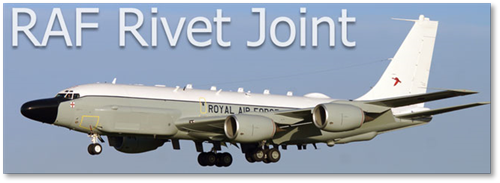
Britain is to receive its second Rivet Joint reconnaissance aircraft in September, seven months ahead of schedule, the Ministry of Defence said.The RC-135 aircraft, called the Airseeker by the British military, is built by Boeing and features modifications by companies such as General Dynamics, Lockheed, LTV, E-Systems and L-3 Communications. It is used to collect, analyze, and disseminate detailed signals intelligence information in support of combat identification and targeting operations.
Britain's first Airseeker is conducting missions over Syria and Iraq against the Islamic State, also known as ISIL. The new aircraft is expected to do the same.
"We're the only coalition nation conducting manned ISR over Syria," Defence Secretary Michael Fallon said Thursday. "And today I can announce that our latest Airseeker plane will be delivered next month, seven months ahead of schedule and will be operational shortly after that in the skies above Iraq and Syria - providing essential intelligence in the fight against ISIL.
"No one, except the U.S., matches our efforts."
Space Daily
"We're the only coalition nation conducting manned ISR over Syria," Defence Secretary Michael Fallon said Thursday. "And today I can announce that our latest Airseeker plane will be delivered next month, seven months ahead of schedule and will be operational shortly after that in the skies above Iraq and Syria - providing essential intelligence in the fight against ISIL.
"No one, except the U.S., matches our efforts."
Space Daily
From: Thomas Iredale, Heidelberg
Sent: Sunday, July 19, 2015 5:31 AM
Subject: The best trip ever!
Hello Tony,
Attached please find my submission for “The best trip ever” in purely graphic form.
Best,
Tom
Sent: Sunday, July 19, 2015 5:31 AM
Subject: The best trip ever!
Hello Tony,
Attached please find my submission for “The best trip ever” in purely graphic form.
Best,
Tom
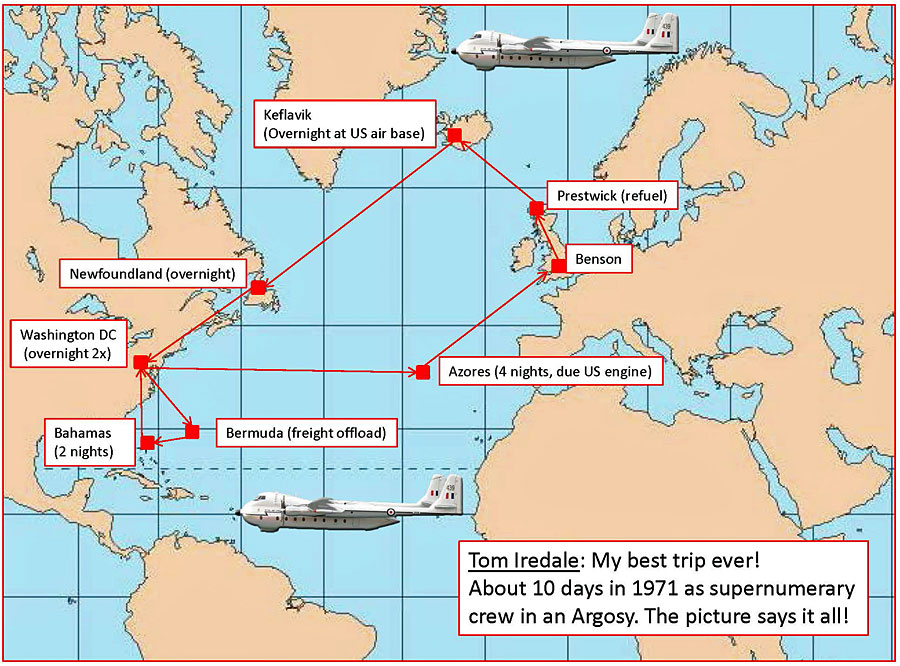
From: Len Bowen, Chisholm, ACT
Sent: Monday, July 20, 2015 2:30 AM
Subject: The best trip ever!
G’day Tony,
MATU ALT1, September 1980. ‘Just for once, MATU gets the Four Star hotel and the Aircrew get the donga’.
It had been decided by the Australian Aid Abroad (ADAB) that our government would generously donate a complete technical college to the Indonesian Government. Said college - well all the hardware from sets of spanners and screw drivers up to lathes, milling machines and several other very large pieces of engineering equipment, anyway - was be delivered to Yogyakarta, on the south side of Java by RAAF aircraft, and all that the Indonesian Education Department then had to do was build four walls round the gear and open the doors for students.
Naturally MATU Team 1 were tasked to do the off-loading at Yogyakarta (hereafter abbreviated to ‘Jogjo’). The crated equipment was so bulky that three Herc sorties would be needed to move the gear from Darwin to Jogjo, and bonus, was also so bulky that the Herc couldn’t carry pax at the same time as the last two loads, so, oh dear oh dear, MATU would have to remain in Jogjo each night while the aircraft returned to Darwin to reload for the following day.
Sent: Monday, July 20, 2015 2:30 AM
Subject: The best trip ever!
G’day Tony,
MATU ALT1, September 1980. ‘Just for once, MATU gets the Four Star hotel and the Aircrew get the donga’.
It had been decided by the Australian Aid Abroad (ADAB) that our government would generously donate a complete technical college to the Indonesian Government. Said college - well all the hardware from sets of spanners and screw drivers up to lathes, milling machines and several other very large pieces of engineering equipment, anyway - was be delivered to Yogyakarta, on the south side of Java by RAAF aircraft, and all that the Indonesian Education Department then had to do was build four walls round the gear and open the doors for students.
Naturally MATU Team 1 were tasked to do the off-loading at Yogyakarta (hereafter abbreviated to ‘Jogjo’). The crated equipment was so bulky that three Herc sorties would be needed to move the gear from Darwin to Jogjo, and bonus, was also so bulky that the Herc couldn’t carry pax at the same time as the last two loads, so, oh dear oh dear, MATU would have to remain in Jogjo each night while the aircraft returned to Darwin to reload for the following day.
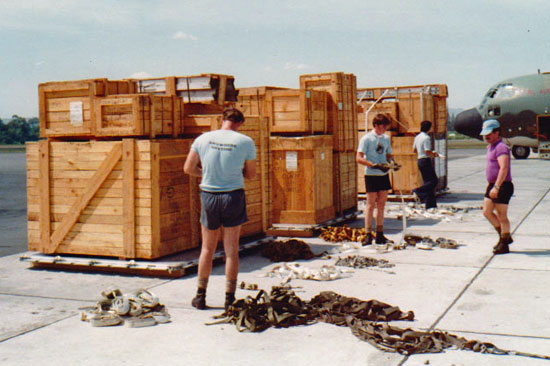
Now here’s the bonus. We, MATU, were accommodated in the Sheraton Hotel in Jogjo while the aircrew were in the transit lines back at RAAF Darwin (this was well before ‘Tin City’ was built) every night. Didn’t happen very often (read that as ‘never’) so we decided to make the most of it.
We deployed on 8th September on 36SQN C130H A97-004, skipper SQNLDR Pickett (who said I’m anal about keeping flight details?) with ‘Big Bertha’, our 12,000 lb fork lift and a full team - see below.
With the aid of Big Bertha the offloads weren’t at all challenging; drop the pallets off the Herc onto dunnage, strip them down and transfer the crated gear onto a fleet of Indonesian trucks - then off to the hotel for a shower, a cold beer or three and lunch by the pool.
We deployed on 8th September on 36SQN C130H A97-004, skipper SQNLDR Pickett (who said I’m anal about keeping flight details?) with ‘Big Bertha’, our 12,000 lb fork lift and a full team - see below.
With the aid of Big Bertha the offloads weren’t at all challenging; drop the pallets off the Herc onto dunnage, strip them down and transfer the crated gear onto a fleet of Indonesian trucks - then off to the hotel for a shower, a cold beer or three and lunch by the pool.
I felt even better that evening when we found that at one end of the hotel there was a beautiful over-water Indonesian restaurant serving a full rijsttafel, with all we could eat for about the equivalent of AUS$15 a head, and Eric the Eski was allowed to accompany us to the table provided we were a little circumspect about how he behaved. Indeed the only fly in the sambals, so to speak, was that one of the team (no names, no pack drill) wouldn’t eat “weird foreign tucker that’s bound to give you gut rot” and insisted on eating in the American Steakhouse bar & grill at the other end of the hotel each night. Being team players, one of us was detailed to accompany the picky eater each night while the rest of us pigged out on twenty different curries and about a hundred different sambals and side dishes. Not only did the nightly steakhouse bills eventually nearly double our food costs when I settled up on departure, but I’ll also give you one guess as to which of us was the only team member to go down with the tropical two-step. Perhaps the beef burgers were more likely water buffalo burgers straight out of the local kampong, but one team member had sole use of the ramp toilet on the redeployment to Darwin on the 11th. Enough said!
Unfortunately the deployment lasted only four days. Our time off in Jogjo each afternoon was greatly helped, not only by Eric at lunch times after the daily off-load and in the evening, but also a nice young bloke from the Australian Embassy in Jakarta who came down to act as interpreter for us, and also to set up the formal hand-over of the equipment by the Australian Ambassador to an Indonesian Government rep on the last day. The young fella knew Jogjo like the back of his hand and showed us round all the sights not only the temple ruins of Borobudur, the world’s largest Buddhist archaeological site, but also the cheapest and best places to eat and drink in town - and all on the Australain Embassy’s slop chit too!
Unfortunately the deployment lasted only four days. Our time off in Jogjo each afternoon was greatly helped, not only by Eric at lunch times after the daily off-load and in the evening, but also a nice young bloke from the Australian Embassy in Jakarta who came down to act as interpreter for us, and also to set up the formal hand-over of the equipment by the Australian Ambassador to an Indonesian Government rep on the last day. The young fella knew Jogjo like the back of his hand and showed us round all the sights not only the temple ruins of Borobudur, the world’s largest Buddhist archaeological site, but also the cheapest and best places to eat and drink in town - and all on the Australain Embassy’s slop chit too!
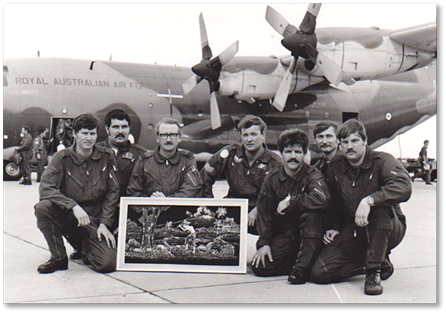
Unfortunately all good things have to come to an end, so it was back to Darwin on the 11th after the formalities were complete, but with a rather nice batik picture to adorn our MATU crew room…. and even though the transit accommodation at RAAF Darwin overnight was something of a come-down after the Sheraton’s four stars and though there was no rijsttafel in the respective Messes, Erik was still there to help pass the evening and end the deployment in the manner to which we had (albeit briefly) become accustomed.
L-R in in the photo on our return to Richmond on 12th September 1980:
LAC (Later SGT) Lance Wouti, LAC (later WOFF ALM) Macca McLaren, Self, SGT Lloyd Bradshaw, LAC Clive Collins, CPL Henry Rycketts, CPL Wayne Norris
L-R in in the photo on our return to Richmond on 12th September 1980:
LAC (Later SGT) Lance Wouti, LAC (later WOFF ALM) Macca McLaren, Self, SGT Lloyd Bradshaw, LAC Clive Collins, CPL Henry Rycketts, CPL Wayne Norris
*Ref Eric the Eski. For Eski read ‘chillybin’ to the Kiwis, ‘icebox’ to the Canucks (though you probably don’t need one with all that snow), and meaningless to the Poms who like their beer warm anyway. (Puts on tin hat and ducks rapidly below trench wall)
Yrs Aye,
Len
Yrs Aye,
Len
With regards to the beer, with the loss of only a couple of six-packs as ‘local goodwill gestures’ we persuaded the Indonesian authorities that Eric the Eski* was a culturally-significant item of great religious significance, akin to the Ark of the Covenant to Australian personnel, and so had to be admitted first into the country and then into the hotel.
As a result we were drinking our own beer - and our duty free from the 36SQN bond store - while at the Sheraton. The first lunch bill I signed for as the imprest holder did scare me a bit, as Macca McLaren our ace fork lift driver and travelling hunger, had decide to try to eat the sate stall beside the pool out of stock before we got down to a real lunch. At first a bill for 27,000 Rupiah (Rp) was a little eye-watering, but when I translated this into about AUS$20 for the six of us, I felt a lot happier.
As a result we were drinking our own beer - and our duty free from the 36SQN bond store - while at the Sheraton. The first lunch bill I signed for as the imprest holder did scare me a bit, as Macca McLaren our ace fork lift driver and travelling hunger, had decide to try to eat the sate stall beside the pool out of stock before we got down to a real lunch. At first a bill for 27,000 Rupiah (Rp) was a little eye-watering, but when I translated this into about AUS$20 for the six of us, I felt a lot happier.
New members joining us recently are:

RAF

RCAF
Glenn 'Fergie' Ferguson, Newquay, Cornwall, UK
Todd Downey, Ottawa, ON, Canada
Welcome to the OBA!
Air Force Blue: Part One
By Lesley Blissett - ex-RAF Supplier
By Lesley Blissett - ex-RAF Supplier

Semi autobiographical tales of the life of a young Royal Air Force girl in the 1980s and 1990s. Outlines her need for intimacy with the opposite sex and her subsequent unhappy marriage. The book is an account of her promiscuous lifestyle coupled with life in the RAF.
The first in a three part series this candidly offers an insight into the life of a WRAF. Sometimes very tongue in cheek with some serious edge. This follows her life and its ups and downs and many heady sexual encounters.
Both funny and sad in places with a great deal of eroticism, be prepared to have your eyes opened!
Available on Amazon
The first in a three part series this candidly offers an insight into the life of a WRAF. Sometimes very tongue in cheek with some serious edge. This follows her life and its ups and downs and many heady sexual encounters.
Both funny and sad in places with a great deal of eroticism, be prepared to have your eyes opened!
Available on Amazon
From: David Stevens, Bangor
Sent: Monday, July 20, 2015 10:49 AM
Subject: The best trip ever!
Dear Tony, you have thrown down the gauntlet this time!
This could bring up some really interesting tales. There again, we all interpret 'best' differently. We had some great trips in those days - the Caribbean, Belize, Norway, Hong Kong, Kenya, Uganda (when the army rebelled!), Tanzania (The Oil Lift), Cyprus (family evacuations), Canada, USA etc etc.
The trip that I will describe was undoubtedly one of my most interesting, and by far the longest:
It started on 25th March 1964 from RAF Lyneham and ended back at RAF Lyneham on 15th May 1964. We were based at RAF Abingdon and so there was the road trip to and fro. 'E' team comprised myself (Plt Off Stevens), Sgt's Mooney and Snell, Cpl Redman and SAC's Gibson and Yeoman.
The destination outbound was Kuching. Our route was via El Adem, Khormaksar, Gan and Changi. After a week in Changi we flew to Kuching. This was the time of the Borneo confrontations; many will remember. Our team was on-loan/seconded/attached to 99 (Ghurkha) Brigade HQ. Cpl Redman and I stayed in Kuching, but the remainder of the team was split up all over Borneo. We were there for almost a month. I did a trip up to Sibu on a Valetta - I have no idea why!
From Kuching we were flown to Ubon, an RAAF base up north in Thailand to take part in Exercise Air Boon Choo (named in honour of a Thai. Air Marshal). Our route from Kuching was via Changi, Seletar and Don Muang. We took an Argosy out of Kuching and then Beverleys all the way.
After a week in Ubon we routed back to Changi (remember my tale of the land rover with the cleanest engine ever? OBB #022715). We spent a week in Changi with the help of the occasional 'Tiger' and then back to the UK via Gan, Khormaksar and El Adem. The journey both out to the Far East and return to the UK was on an RAF comet (XR 397 both times) - kool. Several adventures along the way - most of which are unprintable!
Cheers David
Sent: Monday, July 20, 2015 10:49 AM
Subject: The best trip ever!
Dear Tony, you have thrown down the gauntlet this time!
This could bring up some really interesting tales. There again, we all interpret 'best' differently. We had some great trips in those days - the Caribbean, Belize, Norway, Hong Kong, Kenya, Uganda (when the army rebelled!), Tanzania (The Oil Lift), Cyprus (family evacuations), Canada, USA etc etc.
The trip that I will describe was undoubtedly one of my most interesting, and by far the longest:
It started on 25th March 1964 from RAF Lyneham and ended back at RAF Lyneham on 15th May 1964. We were based at RAF Abingdon and so there was the road trip to and fro. 'E' team comprised myself (Plt Off Stevens), Sgt's Mooney and Snell, Cpl Redman and SAC's Gibson and Yeoman.
The destination outbound was Kuching. Our route was via El Adem, Khormaksar, Gan and Changi. After a week in Changi we flew to Kuching. This was the time of the Borneo confrontations; many will remember. Our team was on-loan/seconded/attached to 99 (Ghurkha) Brigade HQ. Cpl Redman and I stayed in Kuching, but the remainder of the team was split up all over Borneo. We were there for almost a month. I did a trip up to Sibu on a Valetta - I have no idea why!
From Kuching we were flown to Ubon, an RAAF base up north in Thailand to take part in Exercise Air Boon Choo (named in honour of a Thai. Air Marshal). Our route from Kuching was via Changi, Seletar and Don Muang. We took an Argosy out of Kuching and then Beverleys all the way.
After a week in Ubon we routed back to Changi (remember my tale of the land rover with the cleanest engine ever? OBB #022715). We spent a week in Changi with the help of the occasional 'Tiger' and then back to the UK via Gan, Khormaksar and El Adem. The journey both out to the Far East and return to the UK was on an RAF comet (XR 397 both times) - kool. Several adventures along the way - most of which are unprintable!
Cheers David
From: Brian Harper, Glenwood, NL
Sent: Monday, July 20, 2015 6:16 PM
Subject: National Airlines
Good evening Tony,
Have a read of this, I see not a lot has been stated about the loaders - USAF?
Brian
Sent: Monday, July 20, 2015 6:16 PM
Subject: National Airlines
Good evening Tony,
Have a read of this, I see not a lot has been stated about the loaders - USAF?
Brian
A National Airlines Boeing 747-400 freighter that crashed seconds after takeoff from Bagram, Afghanistan, on April 29, 2013, was likely caused by inadequate restraint of large military vehicles being carried onboard, according to a National Transportation Safety Board (NTSB) investigation. The crash killed seven crew members at the start of a journey to Al Maktoum International Airport, Dubai, in the United Arab Emirates.
The aircraft was carrying five mine-resistant ambush-protected (MRAP) vehicles weighing up to 18 tons each, which was being handled on behalf of US Transportation Command.
The crash was captured on the dashboard camera of a vehicle passing Bagram airbase at the time. The 747 was seen climbing steeply immediately after takeoff, before seeming almost to pause a few hundred feet off the ground, rolling approximately 90 degrees starboard and plummeting to the ground, where it burst into flames.
The aircraft was carrying five mine-resistant ambush-protected (MRAP) vehicles weighing up to 18 tons each, which was being handled on behalf of US Transportation Command.
The crash was captured on the dashboard camera of a vehicle passing Bagram airbase at the time. The 747 was seen climbing steeply immediately after takeoff, before seeming almost to pause a few hundred feet off the ground, rolling approximately 90 degrees starboard and plummeting to the ground, where it burst into flames.
According to the NTSB report, it was the first time that National Airlines had attempted to transport five MRAP vehicles. These vehicles were considered a special cargo load because they could not be placed in unit load devices and restrained in the airplane using the locking capabilities of the airplane’s main deck cargo handling system. Instead, the vehicles were secured to centerline-loaded floating pallets and restrained to the airplane’s main deck using tie-down straps.
The NTSB report said that upon takeoff, “the airplane immediately climbed steeply then descended in a manner consistent with an aerodynamic stall.”
The resulting investigation “found strong evidence that at least one of the MRAP vehicles . . . moved aft into the tail section of the airplane, damaging hydraulic systems and horizontal stabilizer components such that it was impossible for the flight crew to regain pitch control of the airplane.”
The report added that the FAA’s “inadequate oversight of National Airlines’ handling of special cargo loads, such as that being carried on the accident flight,” contributed to the accident.
The investigation found that National Airlines’ cargo operations manual not only omitted critical information from Boeing and from the cargo handling system manufacturer about properly securing cargo, but it also contained incorrect restraining methods for special cargo loads.
The NTSB recommended the FAA create a certification process for personnel responsible for the loading, restraint, and documentation of special cargo loads on transport-category airplanes. Other recommendations call on the FAA to improve its ability to inspect cargo aircraft operations, specifically those involving special cargo loads.
The NTSB report said that upon takeoff, “the airplane immediately climbed steeply then descended in a manner consistent with an aerodynamic stall.”
The resulting investigation “found strong evidence that at least one of the MRAP vehicles . . . moved aft into the tail section of the airplane, damaging hydraulic systems and horizontal stabilizer components such that it was impossible for the flight crew to regain pitch control of the airplane.”
The report added that the FAA’s “inadequate oversight of National Airlines’ handling of special cargo loads, such as that being carried on the accident flight,” contributed to the accident.
The investigation found that National Airlines’ cargo operations manual not only omitted critical information from Boeing and from the cargo handling system manufacturer about properly securing cargo, but it also contained incorrect restraining methods for special cargo loads.
The NTSB recommended the FAA create a certification process for personnel responsible for the loading, restraint, and documentation of special cargo loads on transport-category airplanes. Other recommendations call on the FAA to improve its ability to inspect cargo aircraft operations, specifically those involving special cargo loads.
Thanks Brian - this article (origin not known) makes reference to the NTSB report quite often. I obtained this report and made it available for all to download. You can choose to either open it or save it to your computer.
Latest Voyager keeps military mission
Newest ‘surge-fleet’ aircraft will support RAF’s core inventory
of the type, rather than being offered for commercial use
Newest ‘surge-fleet’ aircraft will support RAF’s core inventory
of the type, rather than being offered for commercial use
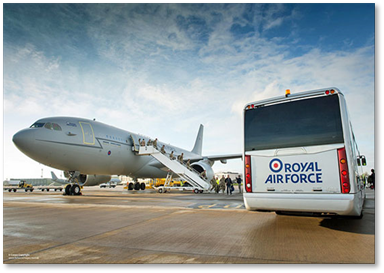
AirTanker is offering its latest Airbus A330 Voyager - acquired as part of the UK’s Future Strategic Tanker Aircraft programme - to enable military operators to move personnel or freight, rather than put the widebody into commercial use. The 12th of an eventual 14 Voyagers is part of a so-called “surge” fleet to be made available to the UK if required beyond a core inventory of eight flown by the Royal Air Force and a ninth that is retained on the civil aircraft register and flown by AirTanker crews.
“We believe there’s value for our UK customers in making this aircraft available to them,” says AirTanker chief executive Phill Blundell. “It would be cheaper to use Voyager than going to the charter sector.” For now, the company will employ KC2-model aircraft ZZ341 to support its existing tasks, but Blundell notes: “If there’s no interest it would be available for the next civilian summer season.”
“We believe there’s value for our UK customers in making this aircraft available to them,” says AirTanker chief executive Phill Blundell. “It would be cheaper to use Voyager than going to the charter sector.” For now, the company will employ KC2-model aircraft ZZ341 to support its existing tasks, but Blundell notes: “If there’s no interest it would be available for the next civilian summer season.”
Longer-term, AirTanker hopes to provide excess capacity to support a European Defence Agency (EDA) initiative to acquire a fleet of A330 tanker/transports for pooled use by the Netherlands, Norway and Poland, for example by supporting personnel training. “We can get them very familiar with the platform,” says Blundell, who says discussions with the EDA have the support of the RAF and Airbus Defence & Space.
Meanwhile, an A330-200 operated by Thomas Cook Airlines since 1 May under a lease agreement with AirTanker has been returned to its facilities at RAF Brize Norton in Oxfordshire for adaptation to the carrier’s 323-seat, all-economy class configuration, as its Acro-supplied replacements were not available in time
for its introduction.
The programme’s first “surge” aircraft had flown more than 23,700 passengers before being returned for the work, which should take around three weeks to complete.
AirTanker’s remaining two Voyagers are scheduled for receipt in January and September 2016. The type has just received final operational clearance to provide in-flight refuelling to the RAF’s Boeing E-3D Sentry airborne warning and control system aircraft, Blundell says.
Flight International
Meanwhile, an A330-200 operated by Thomas Cook Airlines since 1 May under a lease agreement with AirTanker has been returned to its facilities at RAF Brize Norton in Oxfordshire for adaptation to the carrier’s 323-seat, all-economy class configuration, as its Acro-supplied replacements were not available in time
for its introduction.
The programme’s first “surge” aircraft had flown more than 23,700 passengers before being returned for the work, which should take around three weeks to complete.
AirTanker’s remaining two Voyagers are scheduled for receipt in January and September 2016. The type has just received final operational clearance to provide in-flight refuelling to the RAF’s Boeing E-3D Sentry airborne warning and control system aircraft, Blundell says.
Flight International
From: Bill Girdwood, London W5
Sent: Friday, July 24, 2015 12:37 AM
Subject: FEAFMAMS Close down task: RAF Kuantan August/September 1966
Dear Tony,
Sent: Friday, July 24, 2015 12:37 AM
Subject: FEAFMAMS Close down task: RAF Kuantan August/September 1966
Dear Tony,
FEAFMAMS were tasked in mid-1966 with providing Movements support to the CO at RAF Kuantan, Malaysia, during a two month period of closedown of the station. Having recently returned to Seletar from Penang after Operation Hillclimb, my team drew the short straw. However, with the recent influx of new personnel and the shortage of experience, our CO, Bart Pope, decided that we should take a scratch team drawn from across the squadron.
So I found myself working with only one of my team and a handful of strangers. Amongst these were Flt Sgt Ted Turner, a superb chap, Sgt Ernie Blake, very experienced and a great mover, Rab Devlin and from my team, Flint McCullough. Additionally, we had a supplier grafted on to us to do the necessary supply paperwork, SAC David Oliver, who was a great asset and whom we all tried subsequently to persuade to retrain as a mover, but unfortunately without success.
So I found myself working with only one of my team and a handful of strangers. Amongst these were Flt Sgt Ted Turner, a superb chap, Sgt Ernie Blake, very experienced and a great mover, Rab Devlin and from my team, Flint McCullough. Additionally, we had a supplier grafted on to us to do the necessary supply paperwork, SAC David Oliver, who was a great asset and whom we all tried subsequently to persuade to retrain as a mover, but unfortunately without success.
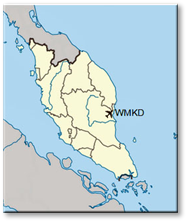
On arrival by road with a couple of Landrovers and a 3-tonner, we were greeted by the CO who was a Flt Lt Air Traffic Controller. He was a little taken aback as he had not envisaged our being quite so keen to get started and was envisaging a slow run down, say over 3 months! Having looked at the volume of stores to be lifted, I thought a couple of weeks would suffice. Little did I know! Included in the task we were to clear what appeared to be a small bomb dump, estimated by the explosives engineers to have about 25 solid practice bombs. On a more careful examination we found about 200 wartime 250 pounders had sunk gradually into the sandy Kuantan soil - and we had a problem!
A Beverley was tasked for 2 days later and duly arrived to move the first loads to Singapore. All went well, but the a/c did not return that day and I started to doubt the timetable which I had devised! The semi-permanent tented camp was being struck and the remaining base personnel were leaving over a 4 or 5 day period. In the evenings, NAAFI had arranged a movie show for all of us but they were then only 5 days away from closing down! Time for a revised assessment.
A Beverley was tasked for 2 days later and duly arrived to move the first loads to Singapore. All went well, but the a/c did not return that day and I started to doubt the timetable which I had devised! The semi-permanent tented camp was being struck and the remaining base personnel were leaving over a 4 or 5 day period. In the evenings, NAAFI had arranged a movie show for all of us but they were then only 5 days away from closing down! Time for a revised assessment.
The LCT managed to jam itself athwart the river as it attempted to turn into the port and we pulled the harbour wall down by using the posts to try to winch it off. Good start but the local harbour master was not too concerned as he anticipated it getting him a wholly redesigned quayside! The river was gently tidal at this point so at high tide Ardennes was duly refloated and positioned slightly down river to receive all the ground equipment and a couple of u/s vehicles. No problems except that Cpl Derek Smith, who had flown back from Singapore with me, disappeared into the river off the ramp, driving a 2500lb FLT and shouting all the while, "No bloody brakes! - No bloody brakes!" FS Ted Turner dragged him out and very quickly attached a hawser to the mast of the FLT and hauled it out with a complaining 3-tonner. We 2-6'd it onto a trailer and took it back to camp for the Malay firemen to clean - bottle of Scotch! - and the following day it was safely loaded. The Malay airport firemen were magnificently uniformed in ceremonial red and blue uniforms and turned out each day with their 1934 Fire Truck, a truly magnificent looking ensemble; I only wish that I had taken some pictures, but alas did not.
The LCT was now moved up to the X dock, and we began to load the bombs. I confess my heart was in my mouth for a lot of the time. Nobody had touched these bombs since the end of the war and Joe's heavy reliance on liquid courage was a burden which I decided to terminate by sending him on leave back to Seletar. We took about 3 weeks to complete the task. We encountered no further problems and the Ardennes sailed safely back to Singapore. We did not hit any major snags, and apart from Rab's encounter with our tame gibbon, later adopted as team mascot and moved to Seletar, during an evening movie before the NAAFI departed. It jumped on him. He screamed; someone in the dark, said "It's only a Tree Fox",to which Rab, unforgettably, swiftly replied,"I don't care tree fox what it is, get it off me!" and David Oliver losing his glasses in the sea whilst swimming. Some time later we found them. I reckon it was a minor miracle.
FEAFMAMS F Team ceremonially lowered the RAF Ensign and gave three resounding cheers for RAF Kuantan and the splendid firemen lowered their heavily worn Union Jack and another small part of the empire came to pass. It is impossible to believe that this little saga was played out in a town, now grown to more than 600,000 people and the 9th largest city in Malaysia. The major economical element is tourism, which, with the wonderful beach that we were able to use almost totally alone, is hardly surprising.
Another wonderful MAMS memory.
And that's about it Tony. I recommend the Wikipedia entry for Kuantan to anyone who has a few spare minutes. It will illustrate the changes so much better than can I!
Bill
FEAFMAMS F Team ceremonially lowered the RAF Ensign and gave three resounding cheers for RAF Kuantan and the splendid firemen lowered their heavily worn Union Jack and another small part of the empire came to pass. It is impossible to believe that this little saga was played out in a town, now grown to more than 600,000 people and the 9th largest city in Malaysia. The major economical element is tourism, which, with the wonderful beach that we were able to use almost totally alone, is hardly surprising.
Another wonderful MAMS memory.
And that's about it Tony. I recommend the Wikipedia entry for Kuantan to anyone who has a few spare minutes. It will illustrate the changes so much better than can I!
Bill
I left Ted and Ernie to investigate further and returned to Base on the scheduled Friendship to re-assess the situation with the boss. We got authority to move the explosives by locally contracted hauliers from the airfield to the port, each load to be escorted and all sorts of safety constraints imposed by the local Malay authorities. We hired a crane, and after a short fight got an imprest and authority to move into the only hotel in Kuantan, unsurprisingly called the Kuantan Hotel. This old edifice only had 5 rooms, no aircon and one shower room and 2 toilets! Such luxury that the team decided it was last resort only and we stayed on the camp for as long as possible.
The RASC were tasked to provide us with an LCT to move the bombs from Kuantan to the RN explosives dock in Singapore and the MS Ardennes duly arrived a couple of days after I had returned. In the meantime, Ernie had been replaced by FS Joe Wolstencroft.
The RASC were tasked to provide us with an LCT to move the bombs from Kuantan to the RN explosives dock in Singapore and the MS Ardennes duly arrived a couple of days after I had returned. In the meantime, Ernie had been replaced by FS Joe Wolstencroft.
Kuantan then was a small town just up-river from the East coast of Malaya, and consisting of about 1500 people, largely engaged in farming and fishing. The little port was to provide us with a most unusual training area, as will become clear. It also had the luxury of a small airport, left over from the Japanese occupation, with a runway long enough to cater for the needs of the daily -- or maybe only twice weekly, my memory is a little hazy on that --Malaysian Airways F27 which bus-stopped up the Malaysian Peninsula from KL to Alor Star and back. 34 Sqn had done a route prover and given it the go-ahead, so we were ready to go.
RAF Akrotiri turns 60 this year
Britain's key base in Cyprus, RAF Akrotiri, turns 60 this year, and Forces TV reporter Simon Newton has been looking at its history.
The base was first built in the mid-1950s to relieve pressure on the main Air Force station on the island, RAF Nicosia, which is now used by the UN's Peacekeeping Force on the island.
In recent years, however, Akrotiri has become the home of Op Shader - Britain's military intervention against Islamic State in Iraq.
We take a look back at the base's colourful history.
Forces TV
The base was first built in the mid-1950s to relieve pressure on the main Air Force station on the island, RAF Nicosia, which is now used by the UN's Peacekeeping Force on the island.
In recent years, however, Akrotiri has become the home of Op Shader - Britain's military intervention against Islamic State in Iraq.
We take a look back at the base's colourful history.
Forces TV
Tony Davies - Long Service in Two Air Forces
Early life
This is the tale of a lad from Liverpool who saw the world and earned an interesting group of medals along the way. My father, Anthony (Tony) Davies, was a flight sergeant in the Royal Air Force and a warrant officer in the Royal Air Force of Oman, and earned long service medals in both.
Born in Liverpool in 1936 and moving to the village of Parbold aged four, Tony remembers seeing and visiting Liverpool during their Blitz. Leaving school at age 15 and gaining employment in a small café, it was going to be only a short while before HM forces requested the pleasure of his company for national service. Tony beat them to it in 1954 when, always having had an interest in aircraft and flight and not wishing to go into the Army or Navy, he volunteered for three years in the Royal Air Force.
This is the tale of a lad from Liverpool who saw the world and earned an interesting group of medals along the way. My father, Anthony (Tony) Davies, was a flight sergeant in the Royal Air Force and a warrant officer in the Royal Air Force of Oman, and earned long service medals in both.
Born in Liverpool in 1936 and moving to the village of Parbold aged four, Tony remembers seeing and visiting Liverpool during their Blitz. Leaving school at age 15 and gaining employment in a small café, it was going to be only a short while before HM forces requested the pleasure of his company for national service. Tony beat them to it in 1954 when, always having had an interest in aircraft and flight and not wishing to go into the Army or Navy, he volunteered for three years in the Royal Air Force.
Tony reported to RAF Cardington which had once been home to the R100/101 airships. His aspirations to become an air gunner were, however, short-lived once the RAF found out about his previous cooking experience. Having completed a cookery test he was advanced to AC1 (aircraftman 1st class) and sent to RAF West Kirby for initial training and square bashing. [Photo at left: The then AC1 Tony Davies (middle row, centre) at the time of his basic entry course in 1954].
Following a stint at RAF Medmenham as relief cook for the AOC (air officer commanding) 90 Group (Signals Command), he was offered a post as cook for the AOC 41 Group (Maintenance Command) cooking for both Air Vice Marshal A. Opie and Air Vice Marshal R.G. Hart, CBE, OBE, MC at Thruxton Manor, RAF Amport. It was here that he had his first flight in an Avro Anson which the AOC sent down with his personal pilot to pick him up. During this flight Tony was required to help lower the undercarriage by vigorous turning of a handle..
Following a stint at RAF Medmenham as relief cook for the AOC (air officer commanding) 90 Group (Signals Command), he was offered a post as cook for the AOC 41 Group (Maintenance Command) cooking for both Air Vice Marshal A. Opie and Air Vice Marshal R.G. Hart, CBE, OBE, MC at Thruxton Manor, RAF Amport. It was here that he had his first flight in an Avro Anson which the AOC sent down with his personal pilot to pick him up. During this flight Tony was required to help lower the undercarriage by vigorous turning of a handle..
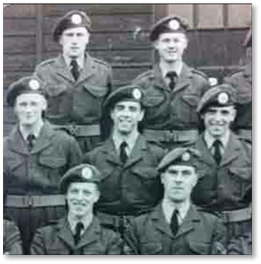
By Andrew Davies
Re-enlistment
Tony re-enlisted into the RAF in 1958 with the same rank and was posted to RAF Hospital Wroughton, working again for the same AOC of 41 Group. This was followed by a short spell at RAF Andover before he was posted to Malta, where he worked in the kitchens of RAF Luqa and Takalia. Malta at this time still had some rationing, including an ice ration for people without a fridge, but the climate and kindness of the Maltese people more than made up for this.
Returning in 1961 to the UK and the transit mess at RAF Lynham, Tony changed trade to stores. He completed his training at Kirton Linsey, followed by a posting in 1963 as forward delivery driver to Bomber Command Strategic School at RAF Feltwell. This involved driving and delivering stores to all the Thor Ballistic Missile sites in Norfolk. Posted to RAF St Mawgan in 1964 and the petrol/oil/lubricants section, Tony had another fated encounter with an aircraft. Travelling to work one day on his Vespa scooter he came close to an aircraft again when he was blown over by the propeller wash from a taxiing Avro Shackleton. Perhaps he took this as a sign as 1965 saw him attend the movements course at RAF Abingdon, this being the pathway to air movements and getting to work on aircraft.
Tony re-enlisted into the RAF in 1958 with the same rank and was posted to RAF Hospital Wroughton, working again for the same AOC of 41 Group. This was followed by a short spell at RAF Andover before he was posted to Malta, where he worked in the kitchens of RAF Luqa and Takalia. Malta at this time still had some rationing, including an ice ration for people without a fridge, but the climate and kindness of the Maltese people more than made up for this.
Returning in 1961 to the UK and the transit mess at RAF Lynham, Tony changed trade to stores. He completed his training at Kirton Linsey, followed by a posting in 1963 as forward delivery driver to Bomber Command Strategic School at RAF Feltwell. This involved driving and delivering stores to all the Thor Ballistic Missile sites in Norfolk. Posted to RAF St Mawgan in 1964 and the petrol/oil/lubricants section, Tony had another fated encounter with an aircraft. Travelling to work one day on his Vespa scooter he came close to an aircraft again when he was blown over by the propeller wash from a taxiing Avro Shackleton. Perhaps he took this as a sign as 1965 saw him attend the movements course at RAF Abingdon, this being the pathway to air movements and getting to work on aircraft.
Airborne at last
Tony was posted to Cyprus in 1965 just as the EOKA terrorist troubles were finishing. The family remained in the safety of England but joined him three months later. He spent a few months in stores at RAF Akrotiri and with promotion to sergeant went to the Air Booking Centre at RAF Episkopi. After two years he returned to RAF Akrotiri and the movements section. It was here after nearly 10 years in the RAF that he finally got to work on aircraft dealing with passengers and freight on a variety of aircraft including Comets, Britannias, VC10s, Hastings, Argosies and Andovers. The station also housed NEAF (Near East Air Force) Vulcans and assorted fighters on summer camp. In Cyprus at the same time was Air Vice Marshal Harold (Micky) Martin of ‘Dambuster’ fame and as a young boy I can recall going with my father to a presentation and talk about the Dambusters given by Air Vice Marshal Martin.
Tony returned home to the UK and RAF Abingdon where on the toss of a coin he joined the UKMAMS (United Kingdom Mobile Air Movements Squadron). It was here that he really learnt about air movements, flying around the world sometimes at a moment’s notice (normally in the middle of the night) in support of various operations. These included the peaceful uprising in Anguilla in 1969, where the only loud noise was that of the steel bands; large-scale exercises in the jungles of the Far East or the Arctic snow in Norway; plus numerous troop reinforcements to Northern Ireland during the troubles. These involved flying into, and operating from, RAF Aldergrove and would involve a large number of flights daily from the UK and RAF Germany to the province depending on the size of the reinforcements. Tony recalls that during one such operation to Northern Ireland they worked continually for nearly 24 hours as reinforcements poured in.
He, like many UKMAM’s personnel and others, did more than 28 days in and out of the troubled province but did not qualify for the ‘NORTHERN IRELAND’ clasp to the General Service Medal 1962-2003 as it was not continuous service. He was also involved in the withdrawal from RAF El Adam in Libya and took part in the last round-the-world flight of Coastal Command Shackletons, when he flew with the support team in the luxury of a Transport Command Britannia - normally they flew in the back of freight aircraft such as a C130 or Argosy.
In the early 1970s Tony flew in and out of the various airfields in the Gulf region including RAF Masirah, RAF Muharraq and RAF Salalah where, on landing, the aircraft were surrounded by mobile oil drum revetments as the Dhofar emergency and shelling from Yemen was still active. Little did he realise that a few short years later he would be back in the Gulf.
Tony was posted to Cyprus in 1965 just as the EOKA terrorist troubles were finishing. The family remained in the safety of England but joined him three months later. He spent a few months in stores at RAF Akrotiri and with promotion to sergeant went to the Air Booking Centre at RAF Episkopi. After two years he returned to RAF Akrotiri and the movements section. It was here after nearly 10 years in the RAF that he finally got to work on aircraft dealing with passengers and freight on a variety of aircraft including Comets, Britannias, VC10s, Hastings, Argosies and Andovers. The station also housed NEAF (Near East Air Force) Vulcans and assorted fighters on summer camp. In Cyprus at the same time was Air Vice Marshal Harold (Micky) Martin of ‘Dambuster’ fame and as a young boy I can recall going with my father to a presentation and talk about the Dambusters given by Air Vice Marshal Martin.
Tony returned home to the UK and RAF Abingdon where on the toss of a coin he joined the UKMAMS (United Kingdom Mobile Air Movements Squadron). It was here that he really learnt about air movements, flying around the world sometimes at a moment’s notice (normally in the middle of the night) in support of various operations. These included the peaceful uprising in Anguilla in 1969, where the only loud noise was that of the steel bands; large-scale exercises in the jungles of the Far East or the Arctic snow in Norway; plus numerous troop reinforcements to Northern Ireland during the troubles. These involved flying into, and operating from, RAF Aldergrove and would involve a large number of flights daily from the UK and RAF Germany to the province depending on the size of the reinforcements. Tony recalls that during one such operation to Northern Ireland they worked continually for nearly 24 hours as reinforcements poured in.
He, like many UKMAM’s personnel and others, did more than 28 days in and out of the troubled province but did not qualify for the ‘NORTHERN IRELAND’ clasp to the General Service Medal 1962-2003 as it was not continuous service. He was also involved in the withdrawal from RAF El Adam in Libya and took part in the last round-the-world flight of Coastal Command Shackletons, when he flew with the support team in the luxury of a Transport Command Britannia - normally they flew in the back of freight aircraft such as a C130 or Argosy.
In the early 1970s Tony flew in and out of the various airfields in the Gulf region including RAF Masirah, RAF Muharraq and RAF Salalah where, on landing, the aircraft were surrounded by mobile oil drum revetments as the Dhofar emergency and shelling from Yemen was still active. Little did he realise that a few short years later he would be back in the Gulf.
The Far East
Leaving UKMAMs after a very busy two years he was posted to Hong Kong and RAF Kai Tak as movements shift sergeant working both at the military and civil side of the airport. During this period, Gurkha personnel were regularly rotated back through Hong Kong to Nepal, and it was here that he met Rambahadur Limbu, VC. Promotion to flight sergeant was followed shortly after by the award of his RAF Long Service and Good Conduct Medal (LSGC) which was presented in the station commander’s office. Soon after he returned to the UK and RAF Hendon (London), looking after service personnel and families that were returning on compassionate flights from all over the world via Heathrow Airport.
After just six months in the UK he returned to the Far East in January 1975 as flight sergeant movements at the RAF Support Unit Tengah, Singapore. This was part of the ANZUK Force (Australia New Zealand United Kingdom).
Leaving UKMAMs after a very busy two years he was posted to Hong Kong and RAF Kai Tak as movements shift sergeant working both at the military and civil side of the airport. During this period, Gurkha personnel were regularly rotated back through Hong Kong to Nepal, and it was here that he met Rambahadur Limbu, VC. Promotion to flight sergeant was followed shortly after by the award of his RAF Long Service and Good Conduct Medal (LSGC) which was presented in the station commander’s office. Soon after he returned to the UK and RAF Hendon (London), looking after service personnel and families that were returning on compassionate flights from all over the world via Heathrow Airport.
After just six months in the UK he returned to the Far East in January 1975 as flight sergeant movements at the RAF Support Unit Tengah, Singapore. This was part of the ANZUK Force (Australia New Zealand United Kingdom).
During the final weeks of the Vietnam War and the collapse of Saigon, because of his UKMAMS' experience Tony flew into Tan San Not airfield in South Vietnam to help with the evacuation of personnel from the British Embassy in Saigon. This involved the RAF C130 Hercules doing a very steep spiral tactical approach/departure as the North Vietnamese were very close to the outskirts and approaching the city itself. He remembers seeing tanks and burning buildings in the surrounding countryside. Saigon fell soon after. [Photo at right: Tan San Not, Saigon - F/Sgt Davies is second from left.]
During his time in Singapore he had the privilege of working on some classic aircraft courtesy of the RAAF - Dakota DC3s and the RNZAF Bristol Freighters B170 similar to those of Silver City Airways fame from the 1950s.
Following a change of government in the UK and withdrawal from ‘East of Suez’, RAF Singapore was closed and British forces withdrawn. Tony and the family departed from tropical Changi nearly a year to the day after we had arrived, on one of the last RAF passenger aircraft to leave Singapore. Returning to a snow-covered UK and RAF Brize Norton.
During his time in Singapore he had the privilege of working on some classic aircraft courtesy of the RAAF - Dakota DC3s and the RNZAF Bristol Freighters B170 similar to those of Silver City Airways fame from the 1950s.
Following a change of government in the UK and withdrawal from ‘East of Suez’, RAF Singapore was closed and British forces withdrawn. Tony and the family departed from tropical Changi nearly a year to the day after we had arrived, on one of the last RAF passenger aircraft to leave Singapore. Returning to a snow-covered UK and RAF Brize Norton.
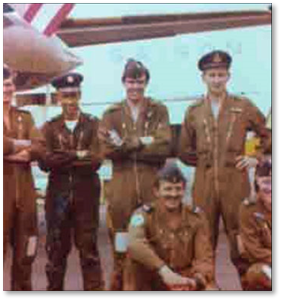
Royal Air Force of Oman
After doing a few odd jobs in the Plymouth area, an advert for a sergeant movements instructor in Oman caught his eye. After successfully applying he arrived in the Sultanate of Oman in 1978 to be greeted at Seeb airport by a former corporal whom he had worked with in the RAF. Sultanate of Oman Air Force (SOAF) at that time, along with the civilian contractor Airworks, employed many ex-service personnel both as contractors and uniformed officers, many of whom held the GSM 1962-2007 for Radfan, South Arabia and Dhofar. SOAF also employed many ex-RAF ‘retired pilots’ with a couple of Air Force Crosses and assorted campaign medals amongst them.
Tony’s induction and orientation was carried out at the whitewashed Fort Bait Al Falajah, a building straight out of Beau Geste. This is now the armed forces of Oman museum. Initially working at SOAF HQ, on promotion to flight sergeant in 1979 he was posted to the former RAF base on the island of Masirah. Here the RAF station name board and crest was still standing with the words SOAF painted over the part that previously read RAF. There were also the remains of the narrow-gauge Masirah state railway which had been used by the RAF to transport stores from the harbour jetty to the camp. The engine and part of the track were returned to the RAF Museum at Cosford and are now on loan to a heritage steam railway in the UK.
After doing a few odd jobs in the Plymouth area, an advert for a sergeant movements instructor in Oman caught his eye. After successfully applying he arrived in the Sultanate of Oman in 1978 to be greeted at Seeb airport by a former corporal whom he had worked with in the RAF. Sultanate of Oman Air Force (SOAF) at that time, along with the civilian contractor Airworks, employed many ex-service personnel both as contractors and uniformed officers, many of whom held the GSM 1962-2007 for Radfan, South Arabia and Dhofar. SOAF also employed many ex-RAF ‘retired pilots’ with a couple of Air Force Crosses and assorted campaign medals amongst them.
Tony’s induction and orientation was carried out at the whitewashed Fort Bait Al Falajah, a building straight out of Beau Geste. This is now the armed forces of Oman museum. Initially working at SOAF HQ, on promotion to flight sergeant in 1979 he was posted to the former RAF base on the island of Masirah. Here the RAF station name board and crest was still standing with the words SOAF painted over the part that previously read RAF. There were also the remains of the narrow-gauge Masirah state railway which had been used by the RAF to transport stores from the harbour jetty to the camp. The engine and part of the track were returned to the RAF Museum at Cosford and are now on loan to a heritage steam railway in the UK.
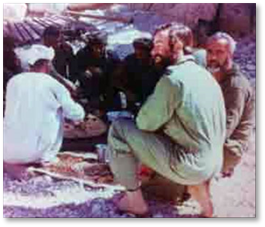
Of the many jobs Tony undertook in Oman, one of his favourites was flying in support of the civil aid programmes. This involved underslung load lifting of building supplies and transporting anything from flour, goats and chickens in the back of helicopters up into the mountains for the local Omani population. [Photo at left: Break for lunch during operations to provide civil aid in Oman. F/Sgt Davies is far right]
He was also involved in transportation of various exotic animals including for the Arabian Oryx breeding programme in the back of SOAF C130 Hercules aircraft. In 1980 he was awarded the Oman Peace Medal, which was awarded to all Omani and uniformed contract officers for completion of one years’ service since 1976.
He was also involved in transportation of various exotic animals including for the Arabian Oryx breeding programme in the back of SOAF C130 Hercules aircraft. In 1980 he was awarded the Oman Peace Medal, which was awarded to all Omani and uniformed contract officers for completion of one years’ service since 1976.
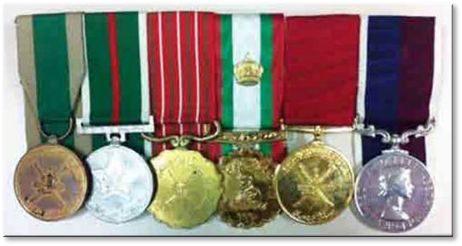
In 1990 the SOAF was renamed the Royal Air Force of Oman (RAFO). After a varied and enjoyable 12 years he finally did the job he had initially been employed for and became the RAFO senior movements instructor, teaching Omani officers and airmen. Following the liberation of Kuwait in the 1990 Gulf War he was part of the movements team that flew into the devastated Kuwait City airport to bring Omani troops home. During 1990 he received both the Oman 20 Year Accession Anniversary Medal and the Omani Forces LSGC. The latter was awarded for 12 years’ service. It was presented to Tony by the Commander, Royal Air Force of Oman, Air Vice Marshal Al Liwa Talib Meran, at a special parade for expatriate officers and senior NCOs.
[Photo below: The medals awarded to Tony Davies for almost four decades of service. From left, Oman Peace Medal 1975; Omani 10, 15 and 20 Year Accession Anniversary Medals; Oman Forces LSGC; RAF LSGC]
[Photo below: The medals awarded to Tony Davies for almost four decades of service. From left, Oman Peace Medal 1975; Omani 10, 15 and 20 Year Accession Anniversary Medals; Oman Forces LSGC; RAF LSGC]
Tony finally retired from Oman and the air force way of life after he had spent the best part of nearly 37 years in uniform, from airman to warrant officer, being awarded long service medals in both the Royal Air Force and Royal Air Force of Oman. Now retired, he lives in Australia.
Reproduced with the kind permission of The Orders and Medals Research Society
Reproduced with the kind permission of The Orders and Medals Research Society
Unfortunately this was as near as he got to an aeroplane for the next three years. During this time Tony was promoted to corporal and, upon completing his three years’ service, left the RAF in 1957. Now married, he spent a tough year in civvy street, working in various hotel and cooking jobs
Tony left the RAF 12 months later after 22 years’ service. During his time he had seen many places around the world, witnessed the dismantling of Empire and the closure of respective overseas bases - not bad for a lad from Liverpool. His single LSGC, like those of many servicemen of his time and generation, reflects only a small part of his service and untold stories
Over the next 14 years Tony was promoted to warrant officer class 2 and then warrant officer class1, becoming the DAMO (Duty Air Movements Officer) both at SOAF Marsiah and SOAF Seeb. In 1980 he was awarded the 10 Year Accession Anniversary Medal, followed in 1985 by the 15 Year Accession Anniversary Medal.
From: Keith Parker, Bowerhill, Wilts
Sent: Wednesday, July 29, 2015 2:34 PM
Subject: My Best Trip!
Hi Tony, here's my offering for “My Best Trip”
Sent: Wednesday, July 29, 2015 2:34 PM
Subject: My Best Trip!
Hi Tony, here's my offering for “My Best Trip”
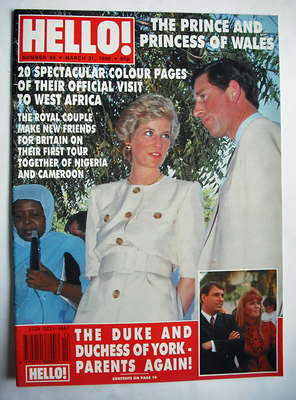
March 14 1990, I was sat in the terminal at Lyneham wondering what the hell I had let myself in for. Shaun Cullighan (our MOPSO and personal long time good friend) stopped me in the corridor outside MAMS Ops and whispered that he wanted to ask me something. Well when MOPSO wants a word it's either, the hotel you stayed in last week wants the mirror back that your team nicked or you have been selected from a cast of one to take on some really sh***y task in the back of beyond. But no, Shaun asked if I would be willing to be “Baggage Master” for Their Royal Highnesses The Prince and Princess of Wales on their tour of Africa. Now remember this was 1990 and Princess Diana was The Princess of Wales and of course I had no hesitation, except one, to ask who if anyone was coming with me and when I found out it was Tim Ketcher I was more than pleased to accept.
In the days that followed I had several things to do; firstly was to touch base with the crew, they were all specially chosen from 242OCU, and we got to know them all extremely well before the flight out which I was reliably informed later was intentional and so all went well.
In the days that followed I had several things to do; firstly was to touch base with the crew, they were all specially chosen from 242OCU, and we got to know them all extremely well before the flight out which I was reliably informed later was intentional and so all went well.
So back to the Pax Terminal on the 14th March 1990. We were gathered up as arranged and were taken out to our Herc which had been loaded up by the shift that night. It was absolutely chokka with wardrobes, boxes of this and that, blood to be kept chilled should an accident occur, which luckily it didn't, bottled water by the pallet load and so on.
Nicely situated just inside the door two para seats for Tim and myself, well, being seasoned MAMS Commandoes we knew that we would find a space to kip - and we did. We landed in Lagos, the capital of Nigeria. We arrived days ahead of the royal couple so, as you do, we had time off to look around - or so we thought. Now the Group Captain in charge ofthe Royal Flight just happened to be the father of one of our team leaders and so barriers were broken straight away. That night we were guests of The Royal Yacht Club, which was another name for The British Club; we had a great night and didn't have to pay for a single drink. The next day, organized by Gp Capt Harrington, was a visit to HMS Britannia, the Royal Yacht; as you can imagine we were overwhelmed. The following day we were at the aircraft early in the morning, sweaty and 'orrible, getting ready. Now the rules are you either arrive ahead of, or behind the “Royals” by one hour and as we were carrying all their stuff our captain rightly decided we should go first.
Nicely situated just inside the door two para seats for Tim and myself, well, being seasoned MAMS Commandoes we knew that we would find a space to kip - and we did. We landed in Lagos, the capital of Nigeria. We arrived days ahead of the royal couple so, as you do, we had time off to look around - or so we thought. Now the Group Captain in charge ofthe Royal Flight just happened to be the father of one of our team leaders and so barriers were broken straight away. That night we were guests of The Royal Yacht Club, which was another name for The British Club; we had a great night and didn't have to pay for a single drink. The next day, organized by Gp Capt Harrington, was a visit to HMS Britannia, the Royal Yacht; as you can imagine we were overwhelmed. The following day we were at the aircraft early in the morning, sweaty and 'orrible, getting ready. Now the rules are you either arrive ahead of, or behind the “Royals” by one hour and as we were carrying all their stuff our captain rightly decided we should go first.
Our first port of call was to a totally unknown place, to me anyway, called Madiguiri (pronounced Mad-oo-gree) not a lot happened there except the chef in the Chinese Restaurant set fire to himself and we were left sitting there waiting.... and waiting.
The Royals of course do their own thing, and the next day we went down stairs to clear the bills and had to sit and wait whilst all the press did likewise. They were awful, all vying for position to get bills paid and get to the airport in time to get an early picture of the Royals. It reminded us of the portrayal in "Spitting Images" of the press as pigs, and seeing them there was exactly like that. Had they been a little less eager to get away they would have seen a car discreetly arrive and its passengers get out and go to the back of the hotel. Tim and I went for a walk around the pool but a very large detective politely asked if we would not go into the pool area as Princess Diana was having her morning dip. And so seeing the last of the press disappear we went back to reception, chuckling to ourselves that the poor old press would be stood out in the midday sun.
Our next stop was Port Harcourt. Nothing much happened there exept the usual Pims' Party with the Royal flight which seemed to take place every time we landed somewhere. I ended up rather the worst for wear, in the newscasters room, same number room, wrong floor. I stood and watched for ten minutes, turned and left without one person seeing me, lucky escape!
The Royals of course do their own thing, and the next day we went down stairs to clear the bills and had to sit and wait whilst all the press did likewise. They were awful, all vying for position to get bills paid and get to the airport in time to get an early picture of the Royals. It reminded us of the portrayal in "Spitting Images" of the press as pigs, and seeing them there was exactly like that. Had they been a little less eager to get away they would have seen a car discreetly arrive and its passengers get out and go to the back of the hotel. Tim and I went for a walk around the pool but a very large detective politely asked if we would not go into the pool area as Princess Diana was having her morning dip. And so seeing the last of the press disappear we went back to reception, chuckling to ourselves that the poor old press would be stood out in the midday sun.
Our next stop was Port Harcourt. Nothing much happened there exept the usual Pims' Party with the Royal flight which seemed to take place every time we landed somewhere. I ended up rather the worst for wear, in the newscasters room, same number room, wrong floor. I stood and watched for ten minutes, turned and left without one person seeing me, lucky escape!
The next day we duly arrived back in Lagos (or Abuja as it is now called) and had to wait whilst Prince Charles inspected a Guard of Honour) we all (the whole crew plus us) were sat on the pan in the shade of a wing watching from the other side of the airfield. The captain devilishly said if Princes Diana looked toward them he would wave, we all thought “Yeah right” When Princess Diana,who had been deserted by her husband, who was still inspecting the troops, suddenly turned and saw us there and waved, well, we all went bonkers, funnily enough we all stood up, and waved like mad. It made our day, but better was to come.
Eventually we found ourselves back in Douala and stood on the pan watching the Royal Flight land and taxi in, no biggy you may say, but we were all lined up, Captain at one end and me at the other. I suddenly looked up and Princess Diana and her entourage were heading straight for us, I say us, but it was straight for me. I stood to attention, didn't know whether to laugh or cry, salute or fart! Luckily it wasn't any, the Princess immediatley put me at my ease by asking if I was the photographer for the group as I had my camera in my hand, to which I whispered yes if that was okay. She kindly agreed and we chatted for a few minutes. What did she say? Well that's between me and Tim.
Eventually we found ourselves back in Douala and stood on the pan watching the Royal Flight land and taxi in, no biggy you may say, but we were all lined up, Captain at one end and me at the other. I suddenly looked up and Princess Diana and her entourage were heading straight for us, I say us, but it was straight for me. I stood to attention, didn't know whether to laugh or cry, salute or fart! Luckily it wasn't any, the Princess immediatley put me at my ease by asking if I was the photographer for the group as I had my camera in my hand, to which I whispered yes if that was okay. She kindly agreed and we chatted for a few minutes. What did she say? Well that's between me and Tim.
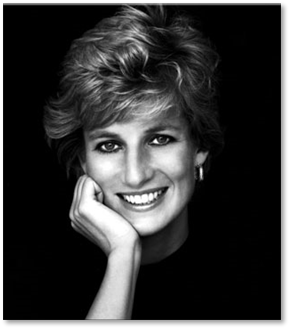
Fastest C-17A delivery in Australian history
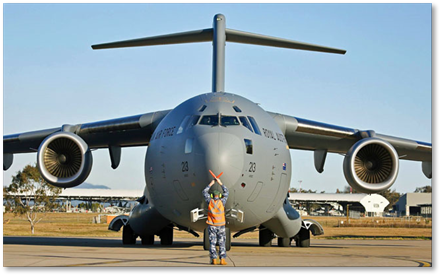
The seventh C-17A Globemaster III aircraft arrived in Australia at RAAF Base Amberley today, Thursday 30th July, marking the fastest C-17A delivery in our fleet. Minister for Defence Kevin Andrews said the rapid acquisition of the aircraft is a testament to the close relationship that exists between Australia and the United States. “The active involvement of a number of United States and Australian agencies has been pivotal in meeting the successful delivery of this aircraft and I applaud everyone involved in the acquisition program,” Minister Andrews said. “This acquisition signifies considerable work opportunities for the local industry, with $300 million being spent to upgrade facilities. With its proven ability to transport heavy equipment, vehicles and helicopters in a short time frame, the C-17A’s capabilities are vital to Australia’s national security and safety.”
Chief of Air Force Air Marshal Leo Davies, AO, CSC said the acquisition of two additional C-17A aircraft will increase the Australian Defence Force’s capacity to provide vital community and humanitarian assistance. “The C-17A fleet has been integral to recent operations including the rapid deployment of Australian forces in support of the Iraq Government , assistance in the Queensland floods, and the recovery of MH17 victims from Eastern Ukraine,” Air Marshal Davies said. “This latest acquisition will bolster our existing fleet of strategic lift aircraft - providing vital heavy airlift support to a range of operations, and increase our capacity to provide swift disaster relief and humanitarian assistance at home and abroad. Under Plan Jericho, the Air Force is dedicated to developing a networked, future joint force that can respond across the spectrum - from combat to humanitarian support. An additional two C-17A aircraft will help us achieve that.”
The Government announced the acquisition of two additional C-17A aircraft in April 2015 representing a $1 billion investment in Australia’s security and Defence Force. The eighth C-17A is planned to arrive in Australia in late 2015.
The Government announced the acquisition of two additional C-17A aircraft in April 2015 representing a $1 billion investment in Australia’s security and Defence Force. The eighth C-17A is planned to arrive in Australia in late 2015.
That's it for this edition
Have a great weekend!
Tony
ukmamsoba@gmail.com
Have a great weekend!
Tony
ukmamsoba@gmail.com







